 Indians Archive
Indians Archive  2008 Indians Preview: The Starters
2008 Indians Preview: The Starters
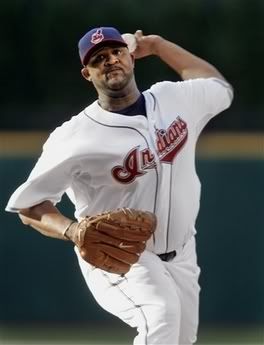 TheClevelandFan.com kicks off its annual Indians preview with a look into the Indians starting rotation for 2008.
TheClevelandFan.com kicks off its annual Indians preview with a look into the Indians starting rotation for 2008.
Flashback: By the Numbers
The Indians return all seven of their starters from a starting staff that last year led the AL in several categories. In fact, going back three years, it is easy to see the most consistent and biggest strength of the team has been the starting pitching.
Last year, the Indians had the best starting staff ERA-wise in the AL, and the peripheral numbers across the board backed up that lofty ERA ranking. In fact, the only areas the starting pitching has struggled the past three years has been in batting average against (BAA) and strikeouts per nine innings (K/9). Of course, this should be of no surprise as the rotation has been filled with groundball pitchers like Fausto Carmona, Jake Westbrook and Aaron Laffey, and pitch to contact pitchers like Paul Byrd and Jeremy Sowers.
Here is a break down of the team pitching stats for the last three seasons, with AL ranks in parentheses:
** - Average rank in ( ) ERA IP BAA OPS WHIP K/BB K/9 2007 4.19 (1st) 1021.1 (1st) .274 (7th) .738 (3rd) 1.31 (3rd) 2.58 (2nd) 5.69 (11th) 2006 4.31 (3rd) 1000.2 (2nd) .285 (12th) .763 (4th) 1.40 (7th) 2.28 (4th) 5.40 (13th) 2005 3.96 (5th) 1006.2 (4th) .257 (3rd) .711 (2nd) 1.26 (4th) 2.50 (3rd) 6.19 (3rd) 3-YR AVG** 4.15 (3rd) 1009.5 (2nd) .272 (7th) .737 (3rd) 1.32 (5th) 2.45 (3rd) 5.76 (9th)
The 2008 Starting Rotation
When you look at the 2008 Indians, once again the rock of the team is the starting rotation. All seven of the main starters used in 2007 are set to return, and even the minor league depth beyond those seven is the same with Adam Miller still in the mix. Last season was the first time the Indians showed some wear in the rotation, as Jake Westbrook and Cliff Lee both missed considerably time due to injury. But, aside from that, the Indians still have had great success in keeping the rotation intact and healthy the last three years.
With two CY Young caliber pitchers at the front of the rotation, and followed by several good pitchers to round out the rotation, there is no question why the Indians have one of the top three starting staffs in baseball. What truly sets this starting rotation apart from any other team is the depth the Indians have from one to seven. Very few teams have three to four good starters, the Indians have seven. There are a lot of teams out there that would love to have any of the losers from this spring's fifth starter battle between Cliff Lee, Aaron Laffey and Jeremy Sowers and use them as their #4 or #5 starter, heck for some teams they could be a #2 or #3 starter.
Instead, as it looks now, the Indians will have two major league caliber pitchers with Sowers and Laffey opening the season in Buffalo, and a third in Miller who is close to being major league ready. That is considerable depth, and an advantage the Indians have that is a separator over every other team. As we saw last season, starters get hurt (Westbrook and Lee) or they perform poorly (Sowers and Lee), and when this happens a team typically struggles. With the depth at this important position on the team, the Indians can withstand the injury bug and performance issues a lot more than most teams.
Here is the Indians starting rotation with a profile of each below:
#1 Starter: C.C. Sabathia LHP
#2 Starter: Fausto Carmona RHP
#3 Starter: Jake Westbrook RHP
#4 Starter: Paul Byrd RHP
#5 Starter: Cliff Lee LHP
#1 Starter: C.C. Sabathia, LHP
| W/L | ERA | IP | BAA | OPS | WHIP | K/9 | K/BB | DIPS | ERA+ | |
| 2007 | 19-7 | 3.21 | 241 | 0.259 | 0.682 | 1.14 | 7.81 | 5.65 | 3.09 | 143 |
 Sabathia had a great season last year, winning the AL CY Young Award and cementing himself as an ace, as well as setting himself up for a big payday after the 2008 season when he becomes a free agent. Since the second half of the 2005 season, Sabathia has been one of the best pitchers in the game. The key to his success has clearly been the ability to throw strikes on a more consistent basis. He jumped from a 2.60 K/BB in 2005 to 3.91 K/BB in 2006 to an unbelievable 5.65 K/BB in 2007. He is an innings eater, and a workhorse in that he has made 30 or more starts in all seven of his major league seasons except one (28 starts in 2006).
Sabathia had a great season last year, winning the AL CY Young Award and cementing himself as an ace, as well as setting himself up for a big payday after the 2008 season when he becomes a free agent. Since the second half of the 2005 season, Sabathia has been one of the best pitchers in the game. The key to his success has clearly been the ability to throw strikes on a more consistent basis. He jumped from a 2.60 K/BB in 2005 to 3.91 K/BB in 2006 to an unbelievable 5.65 K/BB in 2007. He is an innings eater, and a workhorse in that he has made 30 or more starts in all seven of his major league seasons except one (28 starts in 2006).
One thing to pay close attention to this year is how he responds to the heavy workload from last season. Last year was only the second time in his seven year career he has thrown for more than 200 innings in a season, and the first time in five years since he first did it in 2002. It remains to be seen if there is any carryover effect from the heavy workload his arm endured last year where between the regular season and playoffs (15.1 IP) he totaled 256.1 innings pitched. This total was a whopping 62 more innings than his career average coming into last season where he pitched an average of 194.1 innings per year from 2001-2006.
Believe it or not, Sabathia was arguably as good or better in 2006. Sure, he won 19 games in 2008, and only 12 in 2006, but wins are more a team stat that involves so many more intangibles (run support, bullpen effectiveness, etc). In 2006, he had a 3.20 ERA (3.21 ERA in 2007), a 1.17 WHIP (1.14 WHIP), an 8.04 K/9 (7.81 K/9), a .247 BAA (.257 BAA), and a .654 OPS against (.682 OPS). His numbers across the board in 2006 were better except for the win total and his K/BB (3.91 in 2006).
#2 Starter: Fausto Carmona, RHP
| W/L | ERA | IP | BAA | OPS | WHIP | K/9 | K/BB | DIPS | ERA+ | |
| 2007 | 19-8 | 3.06 | 215.0 | .248 | .660 | 1.21 | 5.74 | 2.25 | 3.92 | 151 |
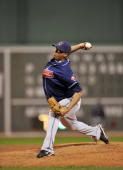 Along with Adam Miller, Carmona was the talk of camp last year as ESPN baseball guru Peter Gammons forecasted Carmona as a player ready to have a big year. Boy was he ever right. The amazing thing about Carmona's season last year, is if not for TWO injuries to the starting staff, we probably never see his sensational breakout campaign. Carmona was destined to start the season in Buffalo as the sixth starter, but when Cliff Lee went down with an oblique injury midway through camp it paved the way for him to open the season as the #5 starter. He pitched very well for a month and a half, but when Lee came back, Carmona was amazingly optioned to Buffalo. But, in an odd twist of fate, Jake Westbrook came up lame and had to go on the disabled list. Carmona had barely packed his bags for Buffalo, and had to unpack them. For good.
Along with Adam Miller, Carmona was the talk of camp last year as ESPN baseball guru Peter Gammons forecasted Carmona as a player ready to have a big year. Boy was he ever right. The amazing thing about Carmona's season last year, is if not for TWO injuries to the starting staff, we probably never see his sensational breakout campaign. Carmona was destined to start the season in Buffalo as the sixth starter, but when Cliff Lee went down with an oblique injury midway through camp it paved the way for him to open the season as the #5 starter. He pitched very well for a month and a half, but when Lee came back, Carmona was amazingly optioned to Buffalo. But, in an odd twist of fate, Jake Westbrook came up lame and had to go on the disabled list. Carmona had barely packed his bags for Buffalo, and had to unpack them. For good. Carmona throws in the mid-to-upper 90s and gets incredible movement on his sinker, but he still has a hard time missing bats. This is nothing new, as he has always had this problem in the minors, and it was one reason why his stock fell some as he moved up the minor league ladder. Still, his bread and butter is getting hitters to pound the ball into the ground (3.48 G/F ratio in 2007) and also limiting the damage of the big hit by opposing hitters (16 HR in 215 IP, .660 OPS).
Carmona went from the #6 starter at the start of spring training, to the #5 starter at the end of spring training, to the #2 starter by mid-season. Talk about a big leap all in a few months. Carmona's emergence was probably the most important development of the Indians' season last year, as without him to come in and help Sabathia anchor the staff while Westbrook, Lee and Jeremy Sowers struggled with injuries and performance issues, the Indians probably do not make the playoffs. If Carmona can build on last season and put up numbers close to those from 2007, he may be an ace in waiting and help lessen the blow of a potential loss of current ace C.C. Sabathia.
#3 Starter: Jake Westbrook, RHP
| W/L | ERA | IP | BAA | OPS | WHIP | K/9 | K/BB | DIPS | ERA+ | |
| 2007 | 6-9 | 4.32 | 152.0 | .276 | .726 | 1.41 | 5.51 | 1.69 | 4.22 | 107 |
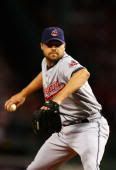 As a middle of the rotation starter, Westbrook is as reliable as they come. Prior to last season, Westbrook had pitched in over 200 innings, made 30 or more starts, and won at least 14 games for three straight seasons from 2004-2006. He won't blow anyone away, but he has a penchant for keeping his defense on its toes by working fast and pitching to contact where opposing hitters pound the ball into the ground (2.68 G/F career ratio). Like Sabathia and Carmona, Westbrook eats innings and gives the Indians a front three in their rotation that is tough to match in a series by just about any other team.
As a middle of the rotation starter, Westbrook is as reliable as they come. Prior to last season, Westbrook had pitched in over 200 innings, made 30 or more starts, and won at least 14 games for three straight seasons from 2004-2006. He won't blow anyone away, but he has a penchant for keeping his defense on its toes by working fast and pitching to contact where opposing hitters pound the ball into the ground (2.68 G/F career ratio). Like Sabathia and Carmona, Westbrook eats innings and gives the Indians a front three in their rotation that is tough to match in a series by just about any other team. Because of his consistency, Westbrook was signed to a three year $33 million extension early in the season last year. The contract extension proved to be a kiss of death, as no sooner was the ink dry on the deal, Westbrook went on the disabled list two weeks later with the dreaded oblique strain. Westbrook essentially missed all of May and June, but even though he missed almost two months, he still managed to rack up over 152 innings.
It took Westbrook awhile to find himself the first half of the season, as the injury and poor April start lead to just nine pre-All Star starts where he went 1-4 with a 6.28 ERA. After the All Star break, he was the Jake of old going 5-5 with a 3.44 ERA in 16 starts and helped the Indians surge past the Detroit Tigers in August going 4-1 with a 1.90 ERA in six starts for the month. While his overall numbers look disappointing, they were actually an improvement over 2006 when he went 15-10 with a 4.17 ERA. In 2006, Westbrook had a .296 BAA (.276 in 2007), .742 (.726), 1.43 WHIP (1.41), 4.64 K/9 (5.51), and 1.98 K/BB (1.69). So, while he was only 6-9 last year as compared to 15-10 in 2006, he actually pitched as good or better in 2007.
#4 Starter: Paul Byrd, RHP
| W/L | ERA | IP | BAA | OPS | WHIP | K/9 | K/BB | DIPS | ERA+ | |
| 2007 | 15-8 | 4.59 | 192.1 | .301 | .800 | 1.39 | 4.12 | 3.14 | 4.50 | 100 |
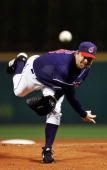 Byrd is one of those pitchers who when you watch pitch you wonder how he has lasted so long in the majors. He throws in the low-to-mid 80s and his secondary stuff is very average. He makes a living off pitching with guts and guile, but the key to his success is that he throws strikes at a ridiculous rate (career 2.16 BB/9) and pitches to contact. He gets hammered for a lot of hits (BAA of over .300 and OPS against over .800 the last two seasons), but by not walking hitters it makes up for all the hits he gives up. His performance against the Red Sox and Yankees in the postseason was masterful, as he dodged and weaved through trouble and the Indians ended up picking up wins in both his starts.
Byrd is one of those pitchers who when you watch pitch you wonder how he has lasted so long in the majors. He throws in the low-to-mid 80s and his secondary stuff is very average. He makes a living off pitching with guts and guile, but the key to his success is that he throws strikes at a ridiculous rate (career 2.16 BB/9) and pitches to contact. He gets hammered for a lot of hits (BAA of over .300 and OPS against over .800 the last two seasons), but by not walking hitters it makes up for all the hits he gives up. His performance against the Red Sox and Yankees in the postseason was masterful, as he dodged and weaved through trouble and the Indians ended up picking up wins in both his starts. During Byrd's time with the Indians, he has benefited from a large amount of run support as in 2006 and 2007 he received an average of six runs or more a game. He was ranked in the top ten in the American League in run support the last two seasons, and this contributed greatly to his favorable win/loss record the past two seasons. While his win/loss percentage was better last year than in 2006 when he was 10-9, Byrd actually was only a little better overall across the board last season as his peripherals improved only slightly. His BAA went from .308 in 2006 to .301 last year, OPS against went from .823 to .800, WHIP went from 1.50 to 1.39, and ERA went from 4.88 to 4.59.
Byrd has admitted to using HGH in the past, and even though he proclaims he used it under the care of a doctor, it remains to be seen if there are any repercussions with a suspension or fine as a result of his announcement. This is also an even numbered year for Byrd, which if you look at his career he always seems to struggle more for whatever reason in even numbered years. At $8 million a year and in his free agent year, Byrd most likely has priced himself out of Cleveland. For what he gives, and with Sabathia commanding a lot more money this offseason, the Indians are likely to let Byrd go after the season. Although, it is possible because of the good relationship Byrd and the Indians have, that if Sabathia bolts in free agency that the Indians could keep Byrd provided he remains healthy and productive in 2008.
#5 Starter: Cliff Lee, LHP
| W/L | ERA | IP | BAA | OPS | WHIP | K/9 | K/BB | DIPS | ERA+ | |
| 2007 | 5-8 | 6.29 | 97.1 | .284 | .838 | 1.52 | 6.10 | 1.83 | 5.20 | 73 |
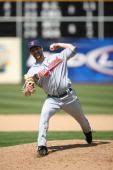 Like Westbrook, for the three years (2004-2006) leading up to last season Cliff Lee was a reliable middle of the rotation starter going a combined 46-24 with a 4.50 ERA during that timeframe. He had also pitched over 200 innings for two straight seasons from 2005-2006, and had never missed a start in his major league career. That all came to an end when Lee was sidelined halfway through spring training with an oblique strain that ended up having him start the season on the disabled list. He was shutdown for almost six weeks, went on a throwing program, and then returned to Cleveland in late May.
Like Westbrook, for the three years (2004-2006) leading up to last season Cliff Lee was a reliable middle of the rotation starter going a combined 46-24 with a 4.50 ERA during that timeframe. He had also pitched over 200 innings for two straight seasons from 2005-2006, and had never missed a start in his major league career. That all came to an end when Lee was sidelined halfway through spring training with an oblique strain that ended up having him start the season on the disabled list. He was shutdown for almost six weeks, went on a throwing program, and then returned to Cleveland in late May. That oblique injury may have been one of the big reasons for Lee's struggles throughout the season last year. When Lee returned at the end of May, he was just not the same pitcher and he looked lost and lacking confidence on the mound. He was unable to properly locate his pitches, and this led to many mistakes where he gave up a lot of walks and extra base hits (.838 OPS), which was against the norm as he has a career .764 OPS against (and that includes last year's inflated number). Since he lost the momentum of pitching and getting ready for the season in spring training, he had to play catch up all year when he came back. Plus, he never seemed comfortable, and if I did not know any better he looked like he was never 100% all year. Whether or not this was the case or not, the injury certainly sidetracked Lee and this is why if he is healthy this year he could be in line for a good comeback season.
Lee is the odds on favorite to be the Indians #5 starter when camp breaks. While Jeremy Sowers and Aaron Laffey should prove to be great competition, it could be what is best for Lee and brings out the best in him. If Lee is not the #5 starter, he will have to be traded as sending him to Buffalo would pretty much destroy not only what little trade value he currently has left, but also could cause a rift between him and the organization. He is on record as saying he signed his extension in late-2006 because he believed that he was wanted here, and has made roundabout comments that he would not be happy with such an assignment to Buffalo. He accepted it last year, but I don't see him being as willing this year if it were to happen. Plus, he will make $4 million this year, and there is no way the cost-conscience Indians pay someone in Buffalo that sum of money. Bottom line, the Indians need to see him through this year because of his past success, especially with Sabathia and Byrd likely gone after the season. The Indians can ill afford to give up any pitching when they will need several options to turn to next year.
Reserve Starter: Jeremy Sowers, LHP
| W/L | ERA | IP | BAA | OPS | WHIP | K/9 | K/BB | DIPS | ERA+ | |
| 2007 | 1-6 | 6.42 | 67.1 | .308 | .858 | 1.56 | 3.21 | 1.14 | 5.36 | 72 |
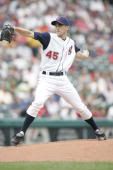 Last season was a season to forget for Sowers. After a sensational second half of the 2006 season where he went 6-2 with a 2.73 ERA and .246 BAA, he went into spring training last year as the unquestioned fifth starter. Sowers just never got it going last year, and a lot of his troubles were the result of just not getting into good counts and locating well where hitters were teeing off on him (.689 OPS against in 2006, .858 OPS against in 2007). Sowers was sent to Buffalo in June to work on his command and get him to trust his stuff again, and after initially struggling in Buffalo for over a month he heated up in August and finished the year very strong. If Sowers' confidence has returned, it will make for an excellent battle for the fifth starter's spot this spring. Even if he does not make the team out of spring training, he will be very good starting depth on-call waiting in Buffalo.
Last season was a season to forget for Sowers. After a sensational second half of the 2006 season where he went 6-2 with a 2.73 ERA and .246 BAA, he went into spring training last year as the unquestioned fifth starter. Sowers just never got it going last year, and a lot of his troubles were the result of just not getting into good counts and locating well where hitters were teeing off on him (.689 OPS against in 2006, .858 OPS against in 2007). Sowers was sent to Buffalo in June to work on his command and get him to trust his stuff again, and after initially struggling in Buffalo for over a month he heated up in August and finished the year very strong. If Sowers' confidence has returned, it will make for an excellent battle for the fifth starter's spot this spring. Even if he does not make the team out of spring training, he will be very good starting depth on-call waiting in Buffalo.
Reserve Starter: Aaron Laffey, LHP
| W/L | ERA | IP | BAA | OPS | WHIP | K/9 | K/BB | DIPS | ERA+ | |
| 2007 | 4-2 | 4.56 | 49.1 | .287 | .726 | 1.34 | 4.56 | 2.08 | 3.79 | 101 |
 Laffey soared through the system last year, and was a player most fans never really heard about until he started getting some pub around the All Star break because of his sensational season at Akron and Buffalo up to that point. Combined at Akron, Buffalo and Cleveland, Laffey went 17-6 with a 3.34 ERA and has established himself as one of the top young starters in the Indians system. What will make Laffey so valuable this year is he can start or pitch in relief, so if a need arises he could pitch in either role. In his small sample size or starts last year in Cleveland, Laffey displayed the moxie and ability to go right after hitters, and he consistently threw strikes (2.09 BB/9 combined last year) and got hitters to pound the ball into the ground (2.81 G/F ratio in 2007). Barring a trade of Cliff Lee, Laffey looks destined to start the year in Buffalo, but he will be seen in Cleveland at some point this season.
Laffey soared through the system last year, and was a player most fans never really heard about until he started getting some pub around the All Star break because of his sensational season at Akron and Buffalo up to that point. Combined at Akron, Buffalo and Cleveland, Laffey went 17-6 with a 3.34 ERA and has established himself as one of the top young starters in the Indians system. What will make Laffey so valuable this year is he can start or pitch in relief, so if a need arises he could pitch in either role. In his small sample size or starts last year in Cleveland, Laffey displayed the moxie and ability to go right after hitters, and he consistently threw strikes (2.09 BB/9 combined last year) and got hitters to pound the ball into the ground (2.81 G/F ratio in 2007). Barring a trade of Cliff Lee, Laffey looks destined to start the year in Buffalo, but he will be seen in Cleveland at some point this season.
Next Wednesday: The Bullpen
- NBA Announces 2013-2014 Schedule
- Browns Ink Sharknado
- Sharknado A No-Show For Rookie Camp
- Trent Richardson Out Until Training Camp
- Browns Sign Brandon Jackson
- Carrasco Suspended Eight Games
- Browns Add to Wide Receiver Depth with David Nelson
- Browns Need to Learn from Past Draft Mistakes
- Browns Release Chris Gocong and Usama Young
- Browns Missing on Grimes Disappointing, But Not The End
The TCF Forums
- The 2014 Offseason Thread
skatingtripods (Tuesday, January 21 2014 11:52 AM) - Official- Browns Coach Search/Rumors
Nicastro13 (Tuesday, January 21 2014 11:45 AM) - Chris Grant's first 3 drafts
Kingpin74 (Tuesday, January 21 2014 10:13 AM) - 2015 Recruiting
furls (Tuesday, January 21 2014 6:57 AM) - Mike Brown
YahooFanChicago (Monday, January 20 2014 11:15 PM) - Movies coming out
HoodooMan (Monday, January 20 2014 9:34 PM) - 2014 Hoops Hockey Hijinx
jpd1224 (Monday, January 20 2014 4:44 PM) - 2014 Recruiting
jclvd_23 (Monday, January 20 2014 2:26 PM) - Wish List - #4 Pick
Hikohadon (Monday, January 20 2014 1:26 PM) - #1 overall pick Anthony Bennett
TouchEmAllTime (Sunday, January 19 2014 1:28 PM)


